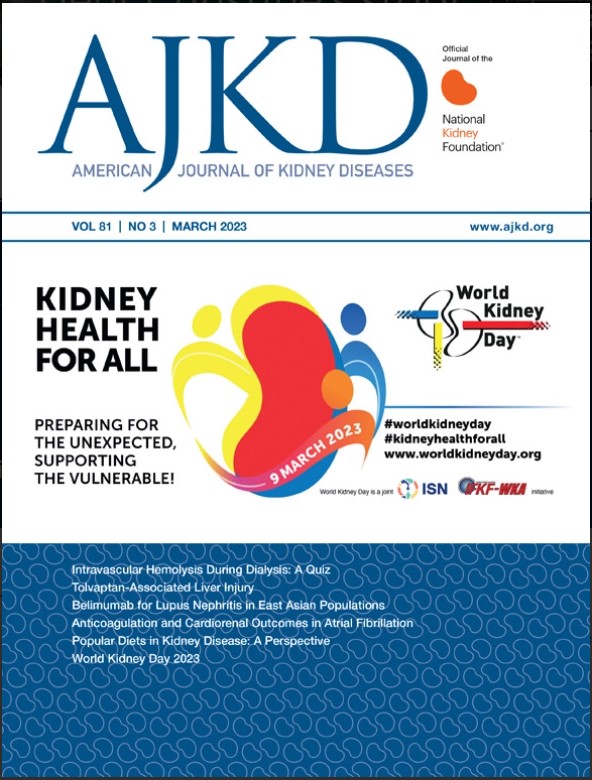Delivery of Palliative Care in the Last Year of Life to Individuals Receiving Maintenance Dialysis: A Population-Level Cross-Sectional Study.
IF 8.2
1区 医学
Q1 UROLOGY & NEPHROLOGY
引用次数: 0
Abstract
RATIONALE & OBJECTIVE Little is known about physician-delivered palliative care and the sociodemographic and clinical factors associated with its utilization for individuals undergoing maintenance dialysis. This study described physician-delivered palliative care in the last year of life and evaluated the factors associated with utilization in this patient population. STUDY DESIGN Population-level cross-sectional study. SETTING & PARTICIPANTS Individuals undergoing maintenance dialysis who died between April 2012 and March 2020 in Ontario, Canada. EXPOSURES Sociodemographic factors (age, sex, immigration status, neighborhood-level income quintile, rurality, health region), comorbidities (heart failure, cirrhosis, pulmonary disease, dementia, malignancy), and kidney-specific factors (dialysis modality, access, duration; and prior kidney transplantation). OUTCOME Physician-delivered palliative care. ANALYTICAL APPROACH Descriptive statistics characterizing physician-delivered palliative care. Logistic regression evaluating the factors associated with utilization. RESULTS 18,452 decedents who underwent maintenance dialysis were included (median age=71 years; 61.1% male). 52.2% received physician-delivered palliative care in the last year of life starting a median of 23 days before death. 65% died in hospital and 12% at home. Palliative care was initiated by a family physician for 68% of those receiving physician-delivered palliative care. It was delivered in the clinic setting for 44.8%, and through a generalist-only model for 46%. The odds of receiving palliative care were higher in the setting of a malignancy, dementia, or cirrhosis; and were lower among those who were recent immigrants, lived in lower-income neighborhoods, and resided in less dense/more rural regions. The odds of dying in hospital were lower among those who received palliative care, especially if it was delivered at home. LIMITATIONS Exclusion of palliative care provided by non-physician providers; and inability to infer causal associations or to comment on the goal-concordance of end-of-life care. CONCLUSIONS Over half of decedents who underwent maintenance dialysis received physician-delivered palliative care in the last year of life, albeit typically starting 3 weeks before death. This may indicate a perception that palliative care is exclusively for end-of-life care. More research is required to identify barriers to delivering equitable palliative care.生命最后一年对接受维持性透析的个体提供姑息治疗:一项人口水平的横断面研究。
理由与目的目前对医生提供的姑息治疗以及与维持性透析患者使用姑息治疗相关的社会人口学和临床因素知之甚少。本研究描述了医生在生命的最后一年提供的姑息治疗,并评估了与该患者群体中使用姑息治疗相关的因素。研究设计:人群水平横断面研究。环境和参与者:2012年4月至2020年3月期间在加拿大安大略省死亡的接受维持性透析的个体。社会人口因素(年龄、性别、移民身份、社区收入水平五分之一、农村地区、卫生地区)、合并症(心力衰竭、肝硬化、肺病、痴呆、恶性肿瘤)和肾脏特异性因素(透析方式、获取途径、持续时间;以及之前的肾移植)。结果:医生提供的姑息治疗。分析方法描述统计特征的医生提供的姑息治疗。Logistic回归评估与利用率相关的因素。结果18,452例患者接受维持性透析(中位年龄=71岁;61.1%的男性)。52.2%的人在生命的最后一年接受了医生提供的姑息治疗,中位数在死亡前23天开始。65%死于医院,12%死于家中。在接受医生提供的姑息治疗的患者中,68%的患者由家庭医生发起姑息治疗。在诊所中提供的比例为44.8%,通过全科医生模式提供的比例为46%。恶性肿瘤、痴呆或肝硬化患者接受姑息治疗的几率更高;而那些新近移民、居住在低收入社区、居住在人口密度较低/较多农村地区的人,则更低。接受姑息治疗的患者,尤其是在家接受姑息治疗的患者,在医院死亡的几率较低。局限性:包括非医师提供的姑息治疗;无法推断因果关系或评论临终关怀的目标一致性。结论:在接受维持性透析治疗的患者中,有一半以上在生命的最后一年接受了医生提供的姑息治疗,尽管通常在死亡前3周开始。这可能表明一种看法,即姑息治疗是专门为临终关怀。需要进行更多的研究,以确定提供公平姑息治疗的障碍。
本文章由计算机程序翻译,如有差异,请以英文原文为准。
求助全文
约1分钟内获得全文
求助全文
来源期刊

American Journal of Kidney Diseases
医学-泌尿学与肾脏学
CiteScore
20.40
自引率
2.30%
发文量
732
审稿时长
3-8 weeks
期刊介绍:
The American Journal of Kidney Diseases (AJKD), the National Kidney Foundation's official journal, is globally recognized for its leadership in clinical nephrology content. Monthly, AJKD publishes original investigations on kidney diseases, hypertension, dialysis therapies, and kidney transplantation. Rigorous peer-review, statistical scrutiny, and a structured format characterize the publication process. Each issue includes case reports unveiling new diseases and potential therapeutic strategies.
 求助内容:
求助内容: 应助结果提醒方式:
应助结果提醒方式:


